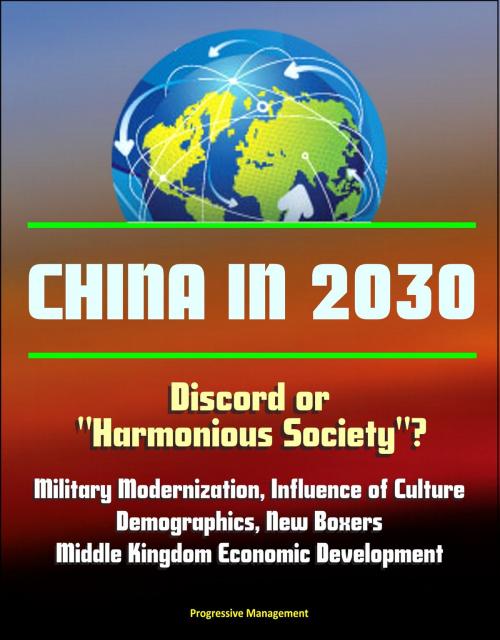China in 2030: Discord or "Harmonious Society"? Military Modernization, Influence of Culture, Demographics, New Boxers, Middle Kingdom Economic Development
Nonfiction, History, Asian, China, Social & Cultural Studies, Political Science| Author: | Progressive Management | ISBN: | 9781310566240 |
| Publisher: | Progressive Management | Publication: | February 6, 2014 |
| Imprint: | Smashwords Edition | Language: | English |
| Author: | Progressive Management |
| ISBN: | 9781310566240 |
| Publisher: | Progressive Management |
| Publication: | February 6, 2014 |
| Imprint: | Smashwords Edition |
| Language: | English |
This vital report from the Department of Defense's Center for Strategy and Technology presents a critical examination of the future of the People's Republic of China as it might exist in the year 2030. Contents: CHAPTER 1 - INTRODUCTION * CHAPTER 2 - THE INFLUENCE OF CULTURE, DEMOGRAPHICS, AND EDUCATION ON THE DEVELOPMENT OF THE MIDDLE KINGDOM * CHAPTER 3 - HARMONIOUS SOCIETY: RISE OF THE NEW BOXERS * CHAPTER 4 - THE PEACEFUL DEVELOPMENT ROAD: CHINA'S ECONOMIC PROGRAM * CHAPTER 5 - CHINA'S MILITARY MODERNIZATION * CHAPTER 6 - HARMONIOUS DISCORDANCE: CHINA IN 2030 * CHAPTER 7 - CONCLUSION: US CAPABILITIES NEEDED TO RESPOND TO POTENTIAL CHINESE CHALLENGES
For more than 5,000 of the 6,000 years of recorded history, China has been the preeminent nation of our planet. While the past two centuries have seen the dominance of the West over the "Middle Kingdom," present trends suggest that this dominance is coming to an end. With its ancient cultural roots intact, the government of China, regarded by many of its people as having a "mandate of heaven," is leading China into the future at almost blinding speed. Within the time frame covered in this monograph, China will supplant the United States as the greatest economic power on Earth. While its military capabilities are expected to lag slightly behind, by 2030 China will be, for all practical purposes, a peer of the United States in terms of its ability to influence interactions within the nation-state system.
The Chinese predilection for indirect methods of handling conflict suggests that, should conflict between the two nations occur, the United States may be faced with challenges for which it is not well prepared. Further, the usual Department of Defense (DOD) myopic focus on the present may be blinding decision makers to the challenges of tomorrow.
That China will be an adversary is not a foregone conclusion. Neither is its friendship. While this study concludes that it is China's intent to seek mutually beneficial relations with the West, internal forces have the potential to drive China toward conflict. Should this occur, the most likely outcome would be a proxy war, where US and Chinese interests could clash.
What is certain is that whatever the actions of China in 2030, the United States must be prepared to handle the challenges these actions present. Handling these challenges will require investments in new systems and technologies, especially in the fields of responsive space, offensive and defense cyberspace, more responsive strategic lift, and survivable tactical lift and long-range strike. Of equal concern will be resolving the internal national debate on which department is really responsible for defending against attacks that produce effects on the territory of the United States itself. This is critical because as with improved offensive cyber-attack capabilities, in a war with a peer China, the homeland military and critical civilian infrastructure will not be immune from a conflict's effects.
This vital report from the Department of Defense's Center for Strategy and Technology presents a critical examination of the future of the People's Republic of China as it might exist in the year 2030. Contents: CHAPTER 1 - INTRODUCTION * CHAPTER 2 - THE INFLUENCE OF CULTURE, DEMOGRAPHICS, AND EDUCATION ON THE DEVELOPMENT OF THE MIDDLE KINGDOM * CHAPTER 3 - HARMONIOUS SOCIETY: RISE OF THE NEW BOXERS * CHAPTER 4 - THE PEACEFUL DEVELOPMENT ROAD: CHINA'S ECONOMIC PROGRAM * CHAPTER 5 - CHINA'S MILITARY MODERNIZATION * CHAPTER 6 - HARMONIOUS DISCORDANCE: CHINA IN 2030 * CHAPTER 7 - CONCLUSION: US CAPABILITIES NEEDED TO RESPOND TO POTENTIAL CHINESE CHALLENGES
For more than 5,000 of the 6,000 years of recorded history, China has been the preeminent nation of our planet. While the past two centuries have seen the dominance of the West over the "Middle Kingdom," present trends suggest that this dominance is coming to an end. With its ancient cultural roots intact, the government of China, regarded by many of its people as having a "mandate of heaven," is leading China into the future at almost blinding speed. Within the time frame covered in this monograph, China will supplant the United States as the greatest economic power on Earth. While its military capabilities are expected to lag slightly behind, by 2030 China will be, for all practical purposes, a peer of the United States in terms of its ability to influence interactions within the nation-state system.
The Chinese predilection for indirect methods of handling conflict suggests that, should conflict between the two nations occur, the United States may be faced with challenges for which it is not well prepared. Further, the usual Department of Defense (DOD) myopic focus on the present may be blinding decision makers to the challenges of tomorrow.
That China will be an adversary is not a foregone conclusion. Neither is its friendship. While this study concludes that it is China's intent to seek mutually beneficial relations with the West, internal forces have the potential to drive China toward conflict. Should this occur, the most likely outcome would be a proxy war, where US and Chinese interests could clash.
What is certain is that whatever the actions of China in 2030, the United States must be prepared to handle the challenges these actions present. Handling these challenges will require investments in new systems and technologies, especially in the fields of responsive space, offensive and defense cyberspace, more responsive strategic lift, and survivable tactical lift and long-range strike. Of equal concern will be resolving the internal national debate on which department is really responsible for defending against attacks that produce effects on the territory of the United States itself. This is critical because as with improved offensive cyber-attack capabilities, in a war with a peer China, the homeland military and critical civilian infrastructure will not be immune from a conflict's effects.















